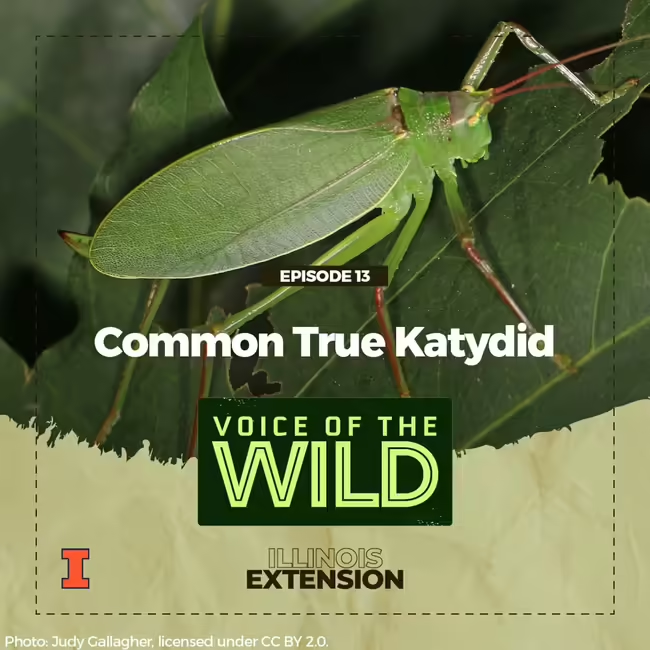
Episode Number
13
Episode Show Notes / Description
Common True Katydid (Pterophylla camellifolia).
This night-singing insect is commonly heard but seldom seen. It’s a master of disguise, with oblong green wing covers that are almost indistinguishable from a leaf. The camouflage is both necessary and appropriate, that’s because this katydid is very nearly flightless! It’s also arboreal, sticking to the tops of trees where it can hide amongst the foliage to feed.
Do you want to learn more bird songs, frog calls, and insect noises? Join Voice of the Wild every Friday to explore a new wild voice. From time to time, we’ll also do a deep dive into wildlife science, news, and natural history. Voice of the Wild is brought to you by the University of Illinois Extension Natural Resources, Environment, and Energy program.
Available on most podcast platforms, including Apple Podcasts, Spotify, and YouTube.
Subscription links Here
Subscribe to the Newsletter
Listen online on our Homepage
Katydid audio clips recorded by Brodie Dunn
Sources and more:
- Common True Katydid. Songs of Insects. Available from http://songsofinsects.com/katydids/common-true-katydid.
- Common True Katydid. Missouri Department of Conservation. Available from https://mdc.mo.gov/discover-nature/field-guide/common-true-katydid.
- Common True Katydid (Pterophylla camellifolia). Singing Insects of North America (SINA). Available from https://orthsoc.org/sina/141a.htm.
Transcript
This is Illinois Extension’s Voice of the Wild. a new wild voice in just a moment, so find someplace quiet, take a deep breath, and enjoy.
This night-singing insect is commonly heard but seldom seen. Its a master of disguise, with oblong green wing covers that are almost indistinguishable from a leaf. The camouflage is both necessary and appropriate, that’s because this katydid is very nearly flightless. Its also arboreal, sticking to the tops of trees where it can hide amongst the foliage to feed. In illinois their pulsed song will start around the fourth of july, growing more cacophonous as more and more males mature into singing adults. As the temperature drops, their calls grow slow and grinding.
This is the common true katydid, Pterophylla camellifolia from the katydid family Tettigoniidae. This family of insects is in the same order as the grasshoppers. orthoptera. Here’s the common true katydid calling again. The first of these calls was recorded mid summer and the second in the fall, when it was much cooler.
Thank you for tuning in to learn a new wild voice with Illinois Extension.
This night-singing insect is commonly heard but seldom seen. Its a master of disguise, with oblong green wing covers that are almost indistinguishable from a leaf. The camouflage is both necessary and appropriate, that’s because this katydid is very nearly flightless. Its also arboreal, sticking to the tops of trees where it can hide amongst the foliage to feed. In illinois their pulsed song will start around the fourth of july, growing more cacophonous as more and more males mature into singing adults. As the temperature drops, their calls grow slow and grinding.
This is the common true katydid, Pterophylla camellifolia from the katydid family Tettigoniidae. This family of insects is in the same order as the grasshoppers. orthoptera. Here’s the common true katydid calling again. The first of these calls was recorded mid summer and the second in the fall, when it was much cooler.
Thank you for tuning in to learn a new wild voice with Illinois Extension.